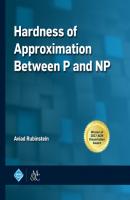Hardness of Approximation Between P and NP. Aviad Rubinstein
Чтение книги онлайн.

Читать онлайн книгу Hardness of Approximation Between P and NP - Aviad Rubinstein страница 23
Название: Hardness of Approximation Between P and NP
Автор: Aviad Rubinstein
Издательство: Ingram
Жанр: Программы
Серия: ACM Books
isbn: 9781947487222
isbn:
■
A similar lemma holds for the second m-tuple of x and the vertex w:
Lemma 3.7
In every ϵ4-ANE
with probability 1 − O(ϵ4) (where the probability is taken over
Lemma 3.8
In every ϵ4-ANE
Proof
Follows immediately from Lemmas 3.6 and 3.7 and the “locality” condition in Proposition 3.1.
■
The following corollary completes the analysis of the 2-player game.
Corollary 3.5
In every ϵ4-ANE
Proof
We recall that in Lemma 3.3 we have proved that
with probability 1 − O(ϵ4). This also implies that x is, with high probability, close to its expectation:
with probability 1 − O(ϵ4). Where the first inequality follows from the triangle inequaltiy, the second follows from the Arithmetic-Mean Geometric-Mean inequality (AM-GM inequalty), the third follows from convexity of
Using that f is O(1)-Lipschitz together with Equation (3.5), we get that
with probability 1 − O(ϵ4).
By Lemma 3.8 we know that
Using similar arguments to those of Lemma 3.3 we can show that
with probability 1 − O(ϵ4). As in the derivation of Equation (3.5), this implies:
with probability 1 − O(ϵ4).
With probability 1 − O(ϵ2), Inequalities (3.5), (3.4), (3.9), (3.8), (3.7), (3.6) hold simultaneously. In such a case, by the triangle inequality and by applying the inequalities in the exact order above, we have
Proof
Proof of Theorem 3.1. Any communication protocol that solves the ϵ4-Nash equilibrium problem in games of size N × N for N = 2Θ(n) induces a communication protocol for the problem SIMULATION END-OF-THE-LINE: Alice constructs her utility in the above presented game using her private information of the αs, Bob constructs his utility using the βs. They implement the communication protocol to find an ϵ4-Nash equilibrium, and then both of them know
Using Corollary 3.4, we deduce that the communication complexity of ϵ4-Nash equilibrium in games of size 2Θ(n) × 2Θ(n) is at least 2Ω(n).
■
3.5.5 n-player Game
Theorem 3.4
Theorem 3.2, restated. There exists a constant ϵ > 0 such that the communication complexity of (ϵ, ϵ)-weak approximate Nash equilibrium in n-player binary-action games is at least 2ϵn.